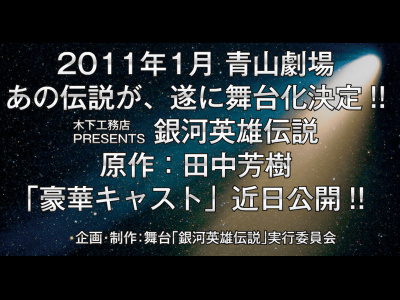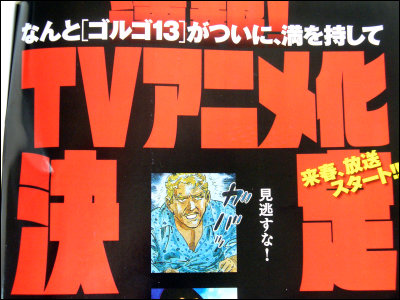I played a 6-player extended version of the board game 'Katan' that sold 30 million sets worldwide.

' Katan ' is a board game that was released in Germany in 1995 and is still very popular. In the year it was released, it won the '
Catan Standard 5-6 person extended version
http://www.gp-inc.jp/boardgame_catan_56.html
The package of the basic set 'Katan Standard Edition' and the additional set 'Katan Standard 5-6 Person Extended Edition' looks like this.

The contents of 'Katan Standard Version' look like this. Contains 6 sea frames, 19 terrain tiles of 6 types, 2 dice, 4 color pieces, 18 number chips, 25 development cards, and 4 construction cost tables.

The expanded version contains 4 sea frames, 11 terrain tiles of 6 types, 2 color frames, 28 number chips, 9 development cards, and 2 construction cost tables. It is used in combination with the standard version, and cannot be played alone.

Use the sea frame to create the outer frame of Catan Island, which will be the stage of the game. In the standard version, 19 terrain tiles make up an island, but in the extended version, the sea frame is one size larger, and 30 terrain tiles make up an island.

The terrain tiles on Catan Island are 'Forage (4 standard version + 2 extended version)' 'Hills (3 + 2)' 'Fields (4 + 2)' 'Pastures (4 + 2)' 'Mountains' There are 6 types: (3 + 2) and 'Desert (1 + 1)'.

There are five types of resource cards: 'wheat', 'ore', 'wood', 'wool', and 'brick', and the corresponding terrain tiles are shown in the background of the card. During the game, these resources will be produced from the corresponding terrain tiles.

There are a total of 5 types of development cards: knight cards, 3 progress cards of 'exclusive', 'discovery', and 'road construction', and point cards. If you use it well, you can advance the game to your advantage.

There are three types of pieces that the player has at hand: 'highway', 'reclaimed land', and 'city'. In addition to this, there is another thief piece that is an obstacle.

Before the game starts, mix and shuffle the standard and extended terrain tiles, then place them in the center row, then the left column, the right column, and so on, as specified in the instructions. .. Then, turn the number chips over, arrange them in a spiral in alphabetical order, and finally turn them over. At this time, do not place the number chips on the desert tile. Finally, place a thief piece on one of the desert tiles and you're ready for Catan.

The goal of the game is to 'get 10 points in advance'. One settlement will be 1 point, 1 city will be 2 points, 1 point card will be 1 point, and if you lay 5 or more longest roads, you will get 2 points and 3 'longest trade routes' bonuses. If you issue the above knight cards, you will get 2 points with the 'Maximum Knights' bonus, so you need to combine them well and aim for points.
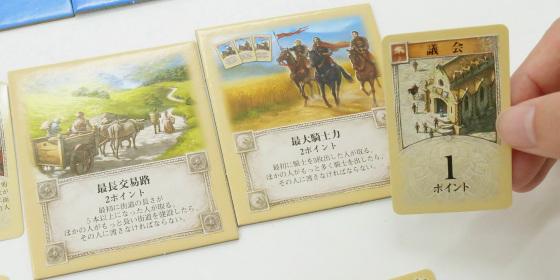
First, roll the dice to decide the start player, and arrange the settlement and the highway one by one in order up to the sixth person. After finishing the placement, we will place the 6th to 5th, 4th, and so on, and the second settlement and highway. At the beginning of the game, you can get resources from the tiles adjacent to the second settlement, so the point is where to put the second settlement as well as the first settlement. In addition, the settlement is placed at the intersection of 3 tiles (one of the tiles can be a sea frame), but since there is a rule that the settlements must not be next to each other, other players will place the settlements. In many cases, it is not possible to place a settlement at the point you were aiming for.

For example, a white player puts a second settlement at the intersection of 'forest,' 'field,' and 'mountain,' so he gets wood, wheat, and ore. Keep the resource card face down.

The game has finally started. The active player rolls two dice, and all players who have a settlement or city around the tile with the total number chips on the roll will get a resource card from the tile. Here, a '4' came out, so the green player who had settled in the land adjacent to the 4 forest tiles got 1 timber. Since there are multiple same numbers, do the same for other tiles.

When you receive the resource card, take individual actions. You can create a 'road', 'reclaimed land', 'city' or draw a 'development card' by paying the cost as shown in the construction cost table at hand.
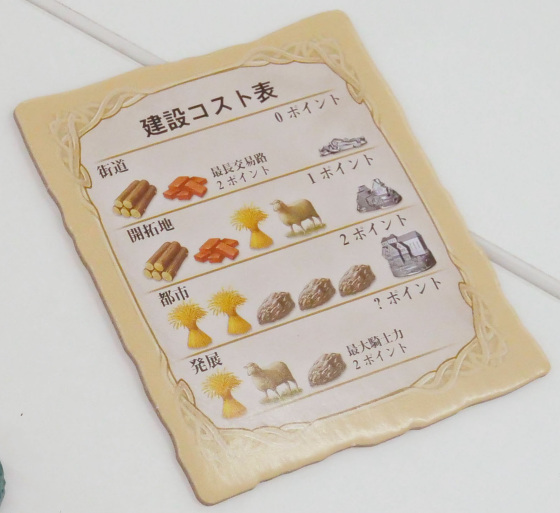
I need points to win, so I would like to create a settlement and further develop the settlement into a city, but 'new settlement needs to be connected to the existing settlement by a highway.' There is a rule that 'the grounds cannot be adjacent to each other', so the first thing you need to make is a highway. The white player paid wood and bricks to extend the road.
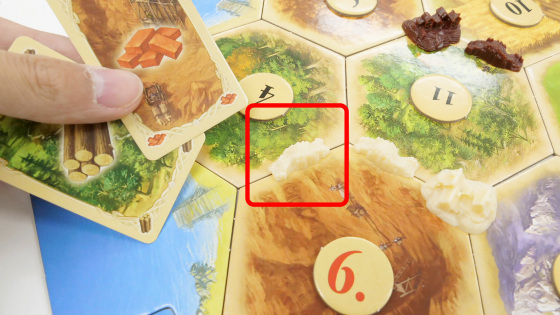
It would be nice if the resources were produced from the tiles, but the dice rolls are capricious, so you may not always get the resources you want. In such a case, you can exchange resources with other players and banks by using 'Resource Card Exchange' that you can do when it is your turn. Exchange with other players is an 'island transaction' and can be exchanged if the conditions are met in the negotiation of 'which resource you want and which resource you can give out instead'. It is not possible to transfer it free of charge, but you can exchange one or more cards. On the other hand, if you respond to the calyx, it will also lead to telling other players the situation of your hand, 'Is there enough resources?', So how to get around is a showcase of your skill.
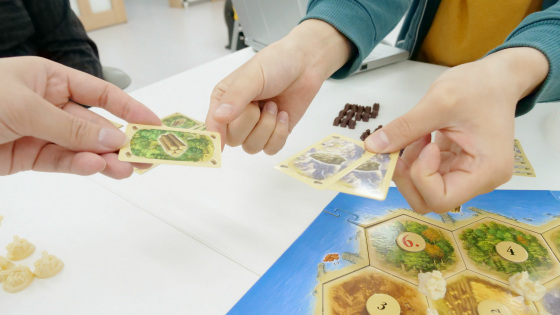
The exchange with the bank is an 'overseas transaction', and you can exchange 4 resources of the same type at hand with 1 arbitrary resource of the bank. In addition, the place where '3: 1' is written on the sea frame is 'general port', and if you are creating a settlement, you will only need 3 resources for trading. In addition, if you have created a settlement in the resource illustration and the 'specialized port' marked '2: 1', you can exchange 2 applicable resources for 1 arbitrary resource.
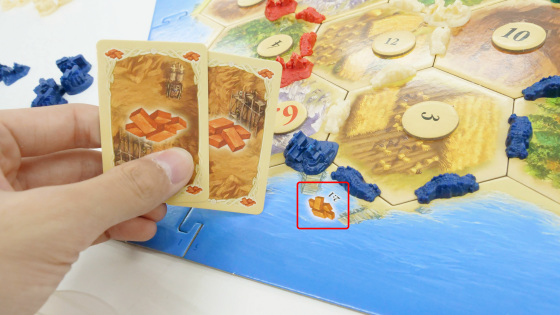
The orange player who skillfully gathered resources builds a settlement. Construction of a settlement requires one each of four types of resources: 'wood', 'brick', 'wheat', and 'wool', but the more settlements you have, the more likely you are to get a resource card.
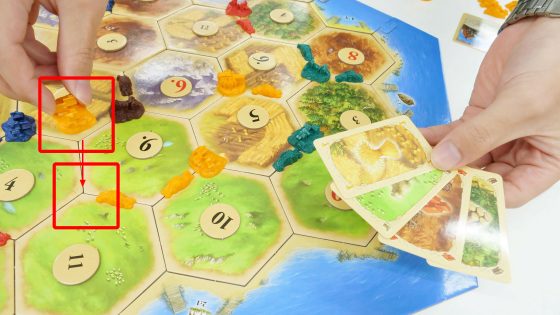
You can also purchase a development card by paying 'wheat', 'wool', and 'ore'. You can't use the development card until the next turn, and you can only use one card at a time in your turn, but you can negotiate and build as many times as you have the resources.

A city built for three 'ores' and two 'wheat' will replace the existing settlement, doubling the amount of resources available from the tiles.
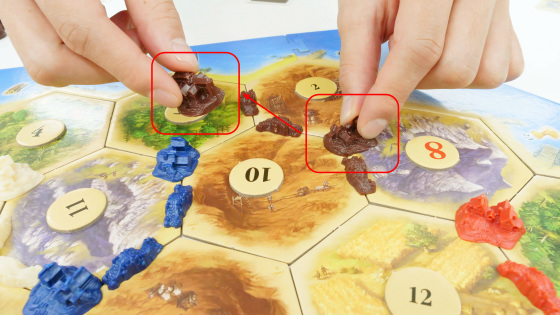
In the standard version, the active player performs five tasks in no particular order: 'resource exchange,' 'construction of highways and settlements,' 'turning settlements into cities,' 'purchasing development cards,' and 'using development cards.' It was the next player's turn, but in the expanded version, when the action of the active player is over, the players other than the active player will in order 'construction of highway / settlement' 'make settlement into city' 'development It is possible to 'purchase a card'. As a result, there are cases where a player who has made an island transaction with a turn player creates a road or settlement before the next person's turn, or purchases a development card.

One of the development cards is a card called 'exclusive'. Players who use 'Exclusive' can collect all cards of the specified type from all players. The white player who used it is happy to collect the resource card 'Ore'. You can't see what cards other players have, so you have to guess what cards everyone has.
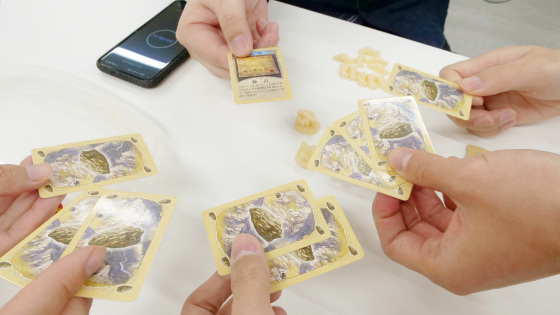
Resource cards can be used for a variety of purposes, but if you have too many, you may be hit by a big disaster. If the total number of dice rolled by someone reaches 7, the thief will start moving.
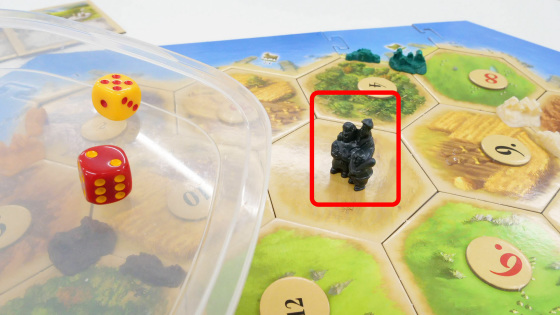
At this time, the player who has 8 or more resource cards must select and discard half of the resource cards. The player who had 9 cards decided to cry and throw away the 4 cards that were rounded down. It seems that resource cards should be consumed well and kept at 7 or less at all times.

The player who rolls 7 can move the thief to another tile, and if there is a settlement around the tile, he can steal a resource card from its owner. Also, you will not be able to receive resource cards from tiles with bandits until the bandits move. Red and blue players will not be able to get resource cards from this 'Forest' tile with a '5' unless the bandit is moved somewhere.
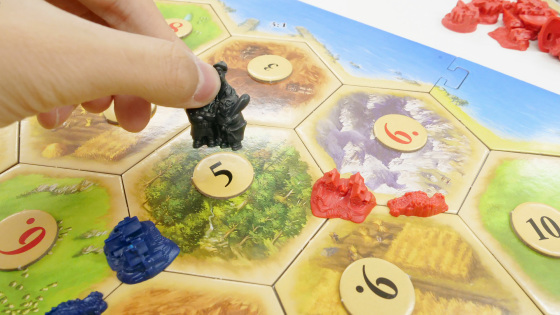
You can also move the bandit to another tile by using the 'Knight' development card. If you use the first 3 knight cards, you can get the bonus card 'Maximum Knight Power' which is worth 2 points just by holding it. But if others use it more, you will be robbed of your card.

You can get the bonus card 'Longest Trade Route' by connecting 5 highways without being disturbed by other people. This is also a card that gives you 2 points just by holding it, but if someone else builds a longer road, it will be stolen.

The player who steadily stretched the road and transformed the settlement into a city and won two bonus cards got a total of 10 points and won the victory.
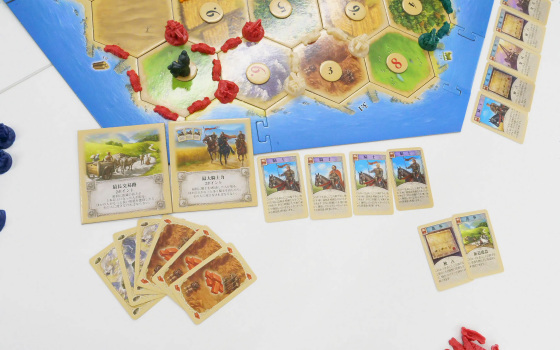
As for the impression of playing the game, the more settlements and cities you place, the more resources you can collect, so it is a good point that you can proceed with the game in an advantageous way as long as you get on track. However, it was a game that would be a little difficult if you were not an accustomed player, because it was greatly influenced by the dice's eyes, and it was difficult to catch up with the player running ahead and aim for a reversal. Also, since the enclosed rule manual is very simple, it seems better to check the rules in advance on the ' Frequently Asked Questions ' page of the official website.
'Katan Standard Edition' and 'Katan Standard 5-6 Person Extended Edition' can be purchased at Amaon.co.jp. At the time of writing the article, 'Katan Standard Edition' is 2800 yen including tax, 'Katan Standard 5-6 person' The 'extended version' is sold for 1427 yen.
Amazon | Catan Standard 5-6 Extended Edition | Board Games | Toys
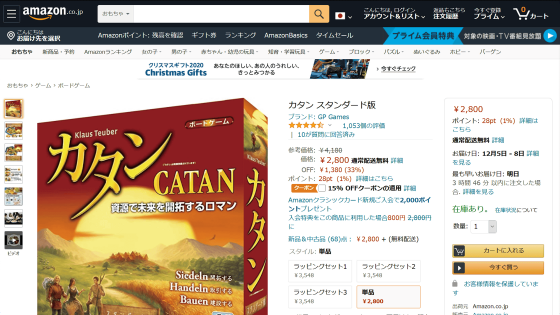
https://www.amazon.co.jp/exec/obidos/ASIN/B017SB7QLO/gigazine-22 Amazon | Catan Standard Version | Toys | Toys
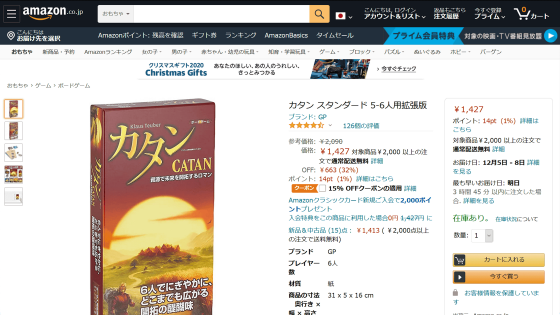
Related Posts:
in Review, Posted by log1p_kr




